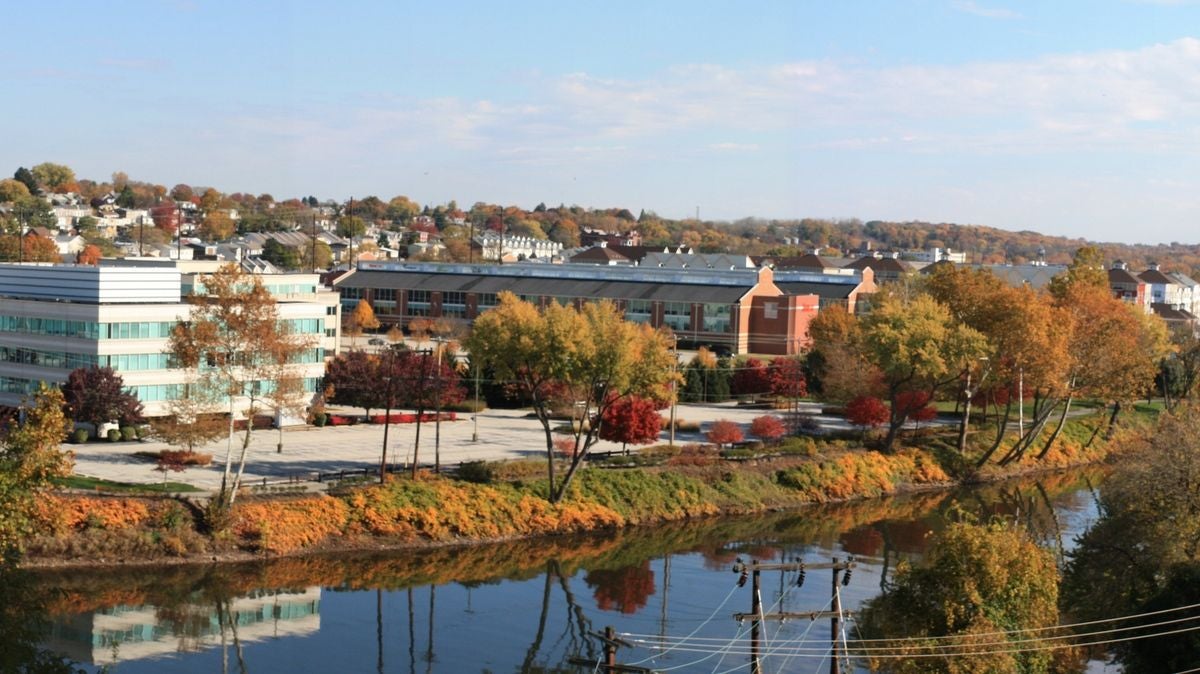In Conshohocken, residents talk about waterfront development, traffic, and walkability

Conshohocken along the Schuylkill River
Residents of Conshohocken talked about the future of their community at a forum on Tuesday night.
Photo courtesy of Flickr user Montgomery County Planning Commission
Conshohocken is a borough on the Schuylkill River in Montgomery County, about 15 miles from Center City Philadelphia. In recent years, the borough has seen a lot of residential and commercial development. It has also become a place of interest for young Philadelphia residents who want to buy a home outside the city.
On Tuesday, about 40 community members got together at a borough firehouse to talk about the future of their municipality. The event, hosted by Conshohocken Revitalization Alliance and MoreThanTheCurve.com, centered around a panel discussion moderated by Keystone’s project editor Naomi Starobin.
The panelists talked about waterfront development, jobs, and perceived clashes between residents.
There were a few points that reminded me, once again, how much Pennsylvania municipalities have in common.
Not a walking city
Kelly Kendrat, a resident who’s in her 30s, said Conshohocken isn’t walkable, especially on its riverfront. “Along the river, it’s just dilapidated buildings and raw sewage and trucks going by,” she said to the panelists. She’d like to see shops and restaurants down by the river.
Where have I heard that before? That seems to be the dream of every city resident.
In April 2015, the borough, together with two local schools, opened a rowing center on the river. It’ll be interesting to see how that fares this season, and what else the borough comes up with.
Job creation
Are new office buildings actually creating jobs, or just moving employees from one location to another? One resident, who has lived in Conshohocken for 37 years, asked this question of Ray Weinmann, president of the Weinmann Group.
This has come up as a concern for residents in many of the cities we report on, especially if development is bankrolled by the local or state government. A number of developers in Conshohocken did receive tax incentives during the 1990s, but the latest developments have not been government-subsidized. Still, residents may be concerned that the borough is getting more office buildings than it needs.
At the event, Weinmann made the argument that new offices create jobs by providing business for industries that serve office workers. For instance, these newly relocated companies need someone to cater their meetings and sell them lunch. “Innumerable businesses that wouldn’t exist if the office building weren’t there, because people in those offices need those services,” Weinmann said.
Just how much impact do those businesses have? That’s debatable. The Department of Community and Economic Development, which awards state economic development incentives, doesn’t measure whether the funding creates jobs at other companies.
Here’s one example where we measured the result: in 2006, Harrah’s opened a casino in Chester that was supposed to draw other businesses to the city. A couple other companies popped up, but on the waterfront, which is separated from the city’s downtown by a highway. And some of the casino’s suppliers are local, but many are not.
Two communities
Some of the panelists said there is a disconnect between longstanding residents and newer ones. Michael Tolle, historian and author of a book about Schuylkill River towns, said some residents are moving to Conshy because they want easy access to interstate highways. They’re going to have a different outlook on where the city’s money should be spent (i.e., on solving the city’s traffic problem), he said, than residents who are more entrenched in the community and perhaps would like to see funding for alternative means of traveling within the borough.
So many cities face this clash of old versus new, and that disconnect can manifest in a wide range of disagreements: like how to spend transportation funding, whether to install bike lanes, or whether to construct a 15-story apartment building. Sometimes those disputes come down to feelings; long-term residents don’t feel like their city belongs to them anymore, and they’re afraid of getting pushed out once rents increase.
I’m not sure how to solve this problem. But getting a diverse group of people together to talk about it is probably a good start.
This was the first of four planned events that’ll bring residents together to talk about Conshohocken’s future. As those events happen, we’ll report on any interesting solutions that could work in other Pennsylvania cities and towns.
Correction: A previous version of this story stated that the Conshohocken Rowing Center opened in August 2014. It opened in April 2015. The story also inaccurately stated that the borough has a public boat launch.
WHYY is your source for fact-based, in-depth journalism and information. As a nonprofit organization, we rely on financial support from readers like you. Please give today.


